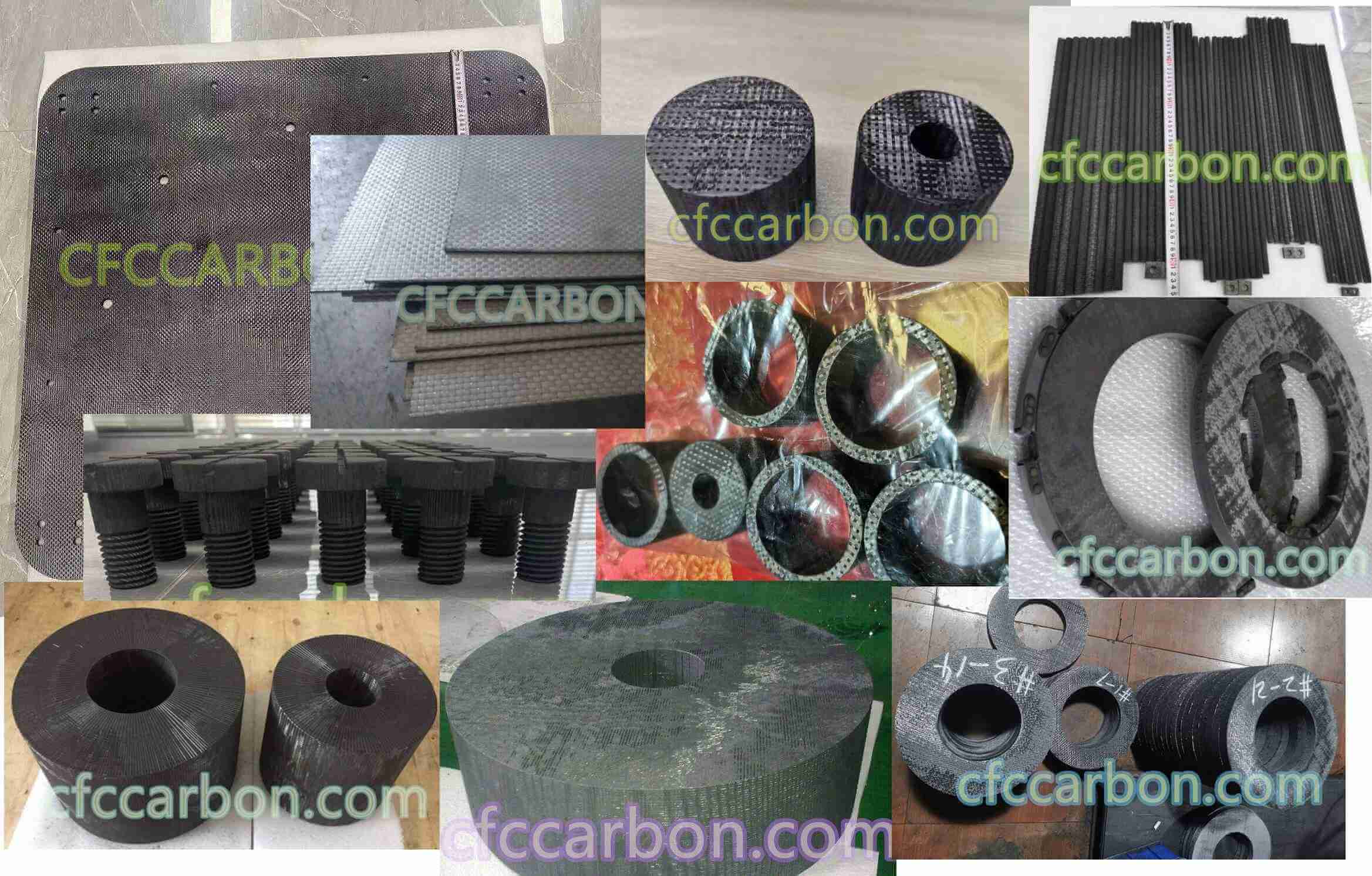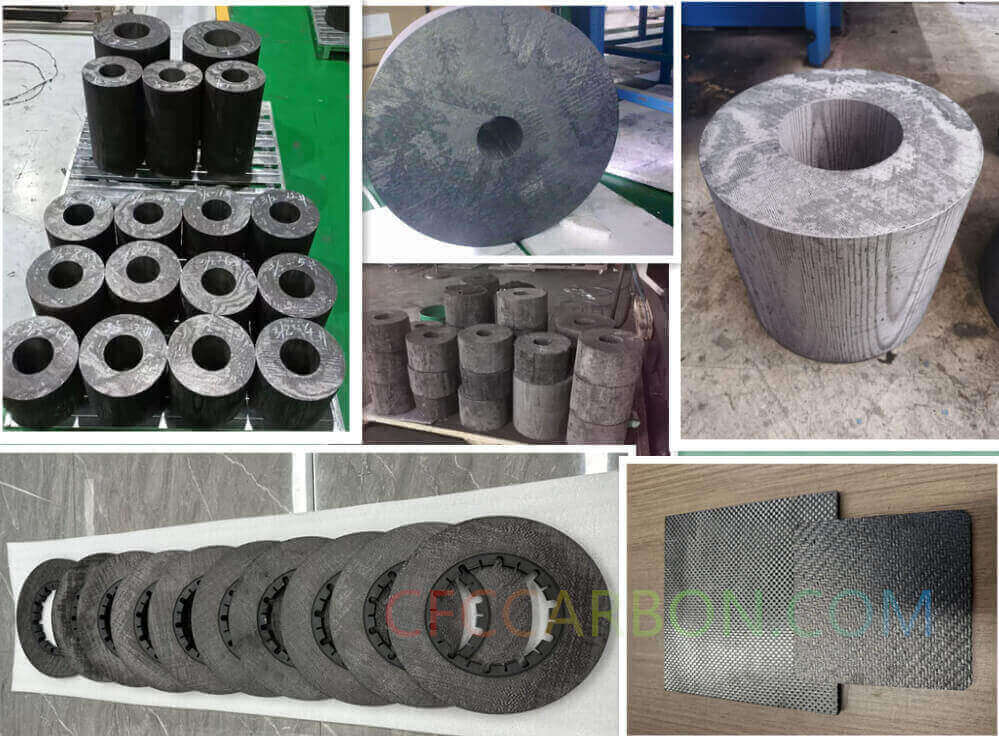Carbonaceous materials have been used as refractory’s, as electrodes in both steelmaking and aluminum production, as moderators for nuclear reactors, rocket nozzles and exhausts, as aircraft brakes, and in various chemical and electrical applications. Initially, the carbons used for each structure were comprised of a granular material bonded together with a carbonized resin or pitch matrix. Improvements in the mechanical properties of structural carbons were obtained by depositing carbon layers from the gas phase. Mechanical properties of this

carbon fiber composite material manufacturer in China(1)
material were superior to those exhibited by the pitch- or resin-bonded material, especially so when measured parallel to the basal plane of the graphite.
Carbon fibers are a relatively recent development in which the basal planes of the graphite-like crystallites are almost parallel to the fiber axis. This arrangement produces a fiber that exhibits a significant anisotropy of properties. The elastic modulus, strength, and electrical conductivity are large parallel to the fiber axis, while the same properties measured transverse to that direction are an order of magnitude smaller. Conversely, the thermal expansion coefficient is small parallel to the fiber axis, but much larger perpendicular to it.
Carbon-carbon composites are fabricated by infiltrating a carbon precursor into a preform of carbon fibers. Chemical vapor infiltration (CVI) directly produces a carbon fiber-reinforced composite at approximately 1000C. Alternatively, similar materials can be formed by heating pitch or resin matrix composites to a temperature of about 1000C. This process eliminates volatile elements from the matrix and “carbonizes” it. The appreciable matrix shrinkage that occurs during carbonization generates pores and cracks. Differences between the coefficient of thermal expansion of the fibers and matrix also generate internal stresses and stress cracks on cooking. The carbonized solid therefore exhibits a low density that

2D 3D 4D 5D carbon fiber composite material manufacturer factory -airplane brake disc plates sheets U L profiles-2D(6)
must be increased to the desired level either by reinfiltration with and carbonization of additional matrix precursor or by CVI with carbon. This process is repeated until acceptable composite density is obtained. Multiple cycles of CVI are also necessary in order to density the solid. Surface machining has to be included in the process since, in most cases, a thick surface layer is formed which tends to prevent diffusion of the hydrocarbon gas into the internal regions of the preform.
If the composite is to be used in very high temperatures, the material may be graphitized by heating above 2000C. Both the fibers and the matrix materials then exhibit increasing graphite-like properties.
The graphitic form of carbon has a hexagonal crystal structure in which each carbon atom is associated with four valence electrons, three of which form tight covalent bonds with neighboring atoms; the fourth is more loosely bound. Since each carbon atom is surrounded by three neighbors at equal distances in a single plane, a hexagonal ring structure results. The layers formed by these rings are primarily bonded together by van der Vaals forces that are much weaker than the covalent bonds.
Carbon fibers, when arranged unidirectionally in any carbon matrix, produce a solid that exhibits anisotropic mechanical properties. In this case, since the fibers take most of the load, both stiffness and strength of the composite are large when measured parallel to the fibers but are small when measured perpendicular to them. In addition, the composite becomes tough because a pseudo-plasticity is exhibited if debonding of the fibers and matrix occurs during failure. The frictional resistance of pulling the fibers out of the matrix behind the crack front then contributes to the work of fracture.
Fibers can be aligned unidirectionally, mutidirectionally, or they can be present as various fiber weaves; these include braided yarns, stacked 2D fabrics, orthogonal fabrics, or multidirectional weaves. An important variable that influences the properties of CC composites is the volume fraction of strong/stiff fibers in a matrix, the greater the strength and stiffness of the composite. The type of weave can vary, with those more commonly used consisting of either a plain weave or a harness satin weave. The harness satin weaves allow a higher volume fraction of fibers and usually produce higher strengths due to the floating yarns. Carbon-carbon composites are generally considered among the most competitive materials in structures designed for use at high temperature. Unfortunately, although their stability is extremely good in nonaggressive mediums, their performance quickly degrades if oxidation occurs. cfccarbon.com
A number of techniques designed to provide some level of oxidation protection have been examined. For instance, the composites can be purified to remove catalytic oxidants, or they can be treated to passivate reactive sites. Such inhibited composites appear useful, especially for low-temperature applications. For high-temperature applications, elements or compounds can be added to serve as oxygen getters, providing constituents for protective glassy films, or providing materials that might diffuse and block oxygen transport through cracks in surface films. Nevertheless, despite all the research activity directed to inhibit oxidation of the matrix, development of an external coating system capable of protecting the total composite is considered essential. This coating system is particularly important if CC composite materials are to be used in long-term high-temperature oxidative environment.
CFCCARBON LTD are the top manufacturer of carbon carbon composite | C/C composite in china, with stable and reliable quality. Our products: 2D,2.5D,3D,4D carbon composite, with density from 1.40-1.95g/cm3, with CVD, CVI processing, or pitch based carbon composite. also, we produce carbon ceramic composite material and products.
Contact Us
related news /articles:
Introduction of carbon carbon composite, CFC, Carbon composite, C/C,
Introduction of manufacturing of carbon fibers-Pan-based carbon fibers
Introduction of high-temperature coatings on CC composite material
Microstructure of Pitch matrix CC composite